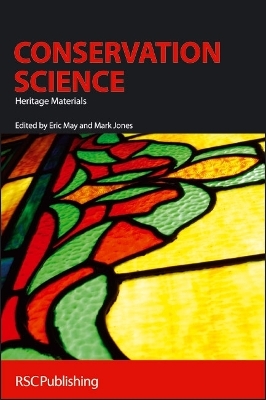
Conservation Science
Royal Society of Chemistry (Verlag)
978-0-85404-659-1 (ISBN)
- Titel erscheint in neuer Auflage
- Artikel merken
PREFACE; CHAPTER ONE: INTRODUCTION; Cultural Heritage: The Archaeologist, The Conservator And The Public - An Essential Coalition; The Archaeologist; The Conservador; From Discovery to Display; Special problems of underwater recovery; The raising of the Mary Rose - a case study; Preservation of the evidence - a multi-discipline task; Conservation with a purpose; Museums - the past into the future; REFERENCES AND FURTHER READING; CHAPTER TWO: METHODS IN CONSERVATION; INTRODUCTION; PRELIMINARY EXAMINATION; ANALYTICAL METHODS; Interaction of radiation with matter; Interaction of elemental particles with matter; Dating Methods; DIAGNOSIS OF DETERIORATION PROCESSES; CONSERVATION TREATMENTS; PREVENTIVE CONSERVATION; REFERENCES AND FURTHER READING; CHAPTER THREE: PAPER; THE CONSTITUENTS OF PAPER; Fibres; Paper size; THE DIRECTIONAL PROPERTIES OF PAPER; HOW PAPER INTERACTS WITH WATER; DETERIORATION OF PAPER; Acid-catalysed hydrolysis of cellulose; Oxidation of cellulose; DEACIDIFICATION; BLEACHING AND WASHING OF PAPER TO REMOVE; DISCOLOURATION; ACCELERATED AGEING TESTS; SAFE ENVIRONMENTS FOR PAPER; METHODS FOR MONITORING THE DETERIORATION OF PAPER; Physical measurements; Chemical methods; CHARACTERISATION OF PAPER; REFERENCES AND FURTHER READING; CHAPTER FOUR: TEXTILES; THE VARIETY OF TEXTILES; TEXTILE MATERIALS; CASE STUDY I: LINEN FIBRES AND THE VICTORY SAIL; The chemical composition and microstructure of linen; The mechanical performance of the Victory sail; Degradation of cellulosic fibres; Humidity and heat; Acid and alkaline hydrolysis; Photolytic damage; Biological degradation; Acidity measurements on the Victory sail; Conservation and display of the Victory fore topsail; CASE STUDY II: SILK FIBRES AND THE SHACKLETON ENSIGN; The chemical composition and microstructure of silk; Silk processing for use as a textile fibre; The condition of the Shackleton ensign; Assessing the condition of silk by microanalytical techniques; Degradation of silk fibres; CASE STUDY III: WOOL FIBRES AND THE TREE OF JESSE TAPESTRY; The Chemical Composition and Microstructure of Wool; Wool as a Textile Fibre; Degradation of Wool; Conservation and Treatment of the Tree of Jesse Tapestry; ENDNOTE; ACKNOWLEDGEMENTS; REFERENCES AND FURTHER READING; CHAPTER FIVE: LEATHER; THE NATURE AND PROPERTIES OF LEATHER; Introduction; Criteria which define tannage; Collagen; Tanning materials; Conclusion; THE MANUFACTURE OF LEATHER; Introduction; Vegetable tanning processes; Alum tawing; Oil tannage; Fur dressing; THE DETERIORATION OF LEATHER; Introduction; Physical deterioration; Biological deterioration; Chemical deterioration; CONSERVATION TECHNIQUES; Introduction; Biological deterioration; Chemical deterioration; Conclusions; REFERENCES; REFERENCES AND FURTHER READING; CHAPTER SIX: METALS; INTRODUCTION; Extraction; Metallurgy; CORROSION; FIELD TREATMENT AND TRANSPORTATION; CONSERVATION; Acid pickling; Aqueous washing; Electrolytic conservation; Hydrogen reduction; STABILISATION AND CONSOLIDATION; REFERENCES AND FURTHER READING; CHAPTER SEVEN: GLASS AND CERAMICS; INTRODUCTION; DETERIORATION AND CONSERVATION OF GLASS; HISTORY, STRUCTURE AND PHYSICAL PROPERTIES; History of glass-making; Structure, technology and physical properties; DEGRADATION MECHANISMS AND PHENOMENA; Basic reactions in water; Degradation of objects indoors; Weathering of stained glass windows; Degradation of archaeological glasses; RESTORATION AND CONSERVATION; Cleaning methods; Coatings, consolidants, adhesives; Conditions for storage and display; DETERIORATION AND CONSERVATION OF CERAMICS; SUMMARY AND CONCLUSIONS; REFERENCES AND FURTHER READING; CHAPTER EIGHT: CONSERVATION SCIENCE OF PLASTICS; PLASTICS IN HERITAGE COLLECTIONS; THE CHEMISTRY AND PHYSICS OF PLASTICS; Preparation of polymers; Additives; Shaping plastics; IDENTIFICATION OF PLASTICS; Simple tests; Instrumental analytical techniques; DEGRADATION OF PLASTICS; Degradation of cellulose nitrate; Degradation of cellulose acetate; Degradation of plasticized PVC; Degradation of polyurethane foam; CONSERVATION OF PLASTICS; Conservation of cellulose nitrate; Conservation of cellulose acetate; Conservation of polyurethane foam; REFERENCES AND FURTHER READING; CHAPTER NINE: STONE; INTRODUCTION; THE DEGRADATION 'EQUATION'; Material; Process; Environment; Limestone Weathering in an Urban Environment: Illustration of the Interaction of the Three Factors; CONSERVATION PRACTICES; Identification; Prevention; Barriers to Agents of Degradation; Removal of Degradation; Consolidation; REPLACEMENT; CONCLUSION; REFERENCES AND FURTHER READING; CHAPTER TEN: WALL PAINTINGS - ASPECTS OF DETERIORATION AND RESTORATION; INTRODUCTION; WALL PAINTINGS AS AN INTEGRAL PART OF BUILDINGS; DAMAGING PROCESSES; Deterioration by soluble salts; Deterioration by microorganisms; Parameters enhancing microbial colonization; Biodeterioration; CLEANING AND CONSOLIDATION; Consolidation; Cleaning methodologies; SUMMARY; REFERENCES AND FURTHER READING; CHAPTER ELEVEN: BIODETERIORATION OF ANCIENT TIMBERS; THE BIODETERIOGENS; Marine wood-boring animals; Teredinids; Erosion bacteria; Tunnelling bacteria; Cavitation bacteria; Bacterial symbionts of shipworm; Soft rot fungi; Basidiomycete fungi; Insect borers; WOOD STRUCTURE; Archaeological wood recovered from the marine environment; Properties and condition of waterlogged archaeological wood; STORAGE OF ARCHAEOLOGICAL WOOD; Wrapping in polyethylene bags or sheeting; Advice to conservators; Storage of large wooden artefacts; The storage of large wooden structures (Mary Rose Hull); Reburial; CONSERVATION OF ARCHAEOLOGICAL WOOD; Definition and aims; Lumen filling treatments; Bulking treatments; Surface coatings; CONSERVATION METHODS; Removal of mineral inclusions; Microbial activity; Polyethylene glycol method; In situ polymerisation with radiation curing monomers and resins; Drying following conservation treatment; CONCLUSIONS; REFERENCES AND FURTHER READING; CHAPTER TWELVE: IN-SITU PRESERVATION OF WATERLOGGED ARCHAEOLOGICAL SITES; IN SITU PRESERVATION; ENVIRONMENTAL MONITORING; Level; Pore water composition; Redox potential; pH; DETERIORATION OF MODERN MATERIALS ANALOGOUS TO ARTEFACTS; WHAT DOES ENVIRONMENTAL MONITORING TELL US IN ITSELF?; Case Study: In situ preservation of the site of Nydam; Deterioration and protection of wooden Artefacts; Deterioration of iron artefacts; SUMMARY; REFERENCES AND FURTHER READING
| Erscheint lt. Verlag | 13.11.2006 |
|---|---|
| Co-Autor | B Des Barker, Paul Wyeth, Margaret Rule, Robert J Koestler, Paul Garside |
| Zusatzinfo | Not illustrated |
| Verlagsort | Cambridge |
| Sprache | englisch |
| Maße | 156 x 234 mm |
| Gewicht | 830 g |
| Themenwelt | Naturwissenschaften ► Biologie ► Ökologie / Naturschutz |
| ISBN-10 | 0-85404-659-3 / 0854046593 |
| ISBN-13 | 978-0-85404-659-1 / 9780854046591 |
| Zustand | Neuware |
| Informationen gemäß Produktsicherheitsverordnung (GPSR) | |
| Haben Sie eine Frage zum Produkt? |
aus dem Bereich



